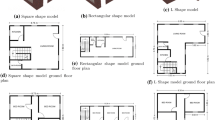Abstract
Double skin facades (DSFs) have gained increasing popularity worldwide for potential building energy savings. Such energy advantages are widely thought to be attributed to the ventilation feature of the DSF cavity. Keeping the cavity open to the outside, however, practically causes noise problems, dust pollution, and safety issues and thereby raising the maintenance cost of DSFs. This paper attempted to bring up this issue for more attention. We first numerically examined the thermal performance of DSF windows based on the climate of Hangzhou City featured by hot summer (>30°C) and cold winter (∼4°C). Then we discussed the potential energy benefits of DSFs and the ventilation design of the cavity. Results from our simulations showed that the DSF window was more energy efficient than a double glazing window in summer regardless of the cavity open or closed. Such energy advantages were more due to the additional pane of the DSF window to reduce the solar transmittance than due to ventilation of the cavity. Although ventilation is beneficial in summer, the annual energy gain may be limited. Our simulations showed that ventilation can save annual energy by no more than 8% under Hangzhou climatic conditions. Therefore, to justify the use of ventilation in a DSF, we recommend a comprehensive evaluation to be performed by balancing the annual energy gains and investment increase associated with the open cavity.
Similar content being viewed by others
References
Balocco C (2001). A simple model to study ventilated facades energy performance. Energy and Buildings, 34: 469–475.
Chan ALS, Chow TT, Fong KF, Lin Z (2009). Investigation on energy performance of double skin facade in Hong Kong. Energy and Buildings, 41: 1135–1142.
Chen Q (1995). Comparison of different k-ɛ models for indoor air flow computations. Numerical Heat Transfer, Part B: Fundamentals, 28: 353–369.
Eckert ERG, Soehngen E (1951). Interferometric studies on the stability and transition to turbulence of a free convection boundary layer. In: Proceedings of General Discussion on Heat Transfer (pp. 321–323), IME/ASME.
Fuliotto R, Cambuli F, Mandas N, Bacchin N, Manara G, Chen Q (2010). Experimental and numerical analysis of heat transfer and airflow on an interactive building facade. Energy and Buildings, 42: 23–28.
Gratia E, De Herde A (2007). Greenhouse effect in double-skin facade. Energy and Buildings, 39: 199–211.
Hamza N (2008). Double versus single skin facades in hot arid areas. Energy and Buildings, 40: 240–248.
Hensen J, Bartak M, Drkal F (2002). Modeling and simulation of a double skin facade system. ASHRAE Transaction, 108(2): 1251–1259.
Holman JP (2005). Heat Transfer, 9th edn. New York: McGraw-Hill.
Høseggen R, Wachenfeldt BJ, Hanssen SO (2008). Building simulation as an assisting tool in decision making: Case study: With or without a double-skin facade? Energy and Buildings, 40: 821–827.
Jiru TE, Haghighat F (2008). Modeling ventilated double skin facade-A zonal approach. Energy and Buildings, 40: 1567–1576.
MacGregor RK, Emery AP (1969). Free convection through vertical plane layers: Moderate and high Prandtl numbers fluids. Journal of Heat Transfer, 91: 391–401.
Manz H (2003). Numerical simulation of heat transfer by natural convection in cavities of facade elements. Energy and Buildings, 35: 305–311.
Manz H (2004). Total solar energy transmittance of glass double facades with free convection. Energy and Buildings, 36: 127–136.
Monson DJ, Seegmiller HL, McConnaughey PK, Chen YS (1990). Comparison of experiment with calculations using curvature- corrected zero and two-equation turbulence models for a two-dimensional U-duct. In: Proceedings of AIAA 21st Fluid Dynamics, Plasma Dynamics and Lasers Conference (AIAA Paper No. 90-1484), Seattle, USA.
Pappas A, Zhai Z (2008). Numerical investigation on thermal performance and correlations of double skin facade with buoyancy-driven airflow. Energy and Buildings, 40: 466–475.
Saelens D, Roels S, Hens H (2004). The inlet temperature as a boundary condition for multiple-skin facade modeling. Energy and Buildings, 36: 825–835.
Safer N, Woloszyn M, Roux JJ (2005). Three-dimensional simulation with a CFD tool of the airflow phenomena in single floor double- skin facade equipped with venetian blind. Solar Energy, 79: 193–203.
Tanaka H, Okumiya M, Tanaka H, Yoon GY, Watanabe K (2009). Thermal characteristics of a double-glazed external wall system with roll screen in cooling season. Building and Environment, 44: 1509–1516.
Wong NH, Wang L, Aida NC, Anupama RP, Wei X (2005). Effects of double glazed facade on energy consumption, thermal comfort and condensation for a typical office building in Singapore. Energy and Buildings, 37: 563–572.
Xu L, Ojima T (2007). Field experiments on natural energy utilization in a residential house with a double skin facade system. Building and Environment, 42: 2014–2023.
Yakhot V, Orzag SA, Thangam S, Gatski TB, Speziak CG (1992). Development of turbulence models for shear flows by a double expansion technique. Physics of Fluids A, 4: 1510–1520.
Yin SH, Wung TY, Chen K (1978). Natural convection in an air layer enclosed within rectangular cavities. International Journal of Heat Mass Transfer, 21: 307–315.
Zerrin Y, Ferit C (2005). Double skin facade’s effects on heat losses of office buildings in Istanbul. Energy and Buildings, 37: 691–697.
Zhao W, Gu J, Yang J, Lin H (2009). The calculation method and characteristics of daily global solar radiation in Hangzhou City. Resources Science, 31(9): 1587–1591. (In Chinese)
Zhao Y, Goss WP, Curcija D, Power JP (1997). A new set of analytical correlations for predicting convective heat transfer in fenestration glazing cavities. In: Proceedings of CLIMA 2000 (pp. 305–316), Brussels, Belgium.
Author information
Authors and Affiliations
Corresponding author
Rights and permissions
About this article
Cite this article
He, G., Shu, L. & Zhang, S. Double skin facades in the hot summer and cold winter zone in China: Cavity open or closed?. Build. Simul. 4, 283–291 (2011). https://doi.org/10.1007/s12273-011-0050-7
Received:
Revised:
Accepted:
Published:
Issue Date:
DOI: https://doi.org/10.1007/s12273-011-0050-7




